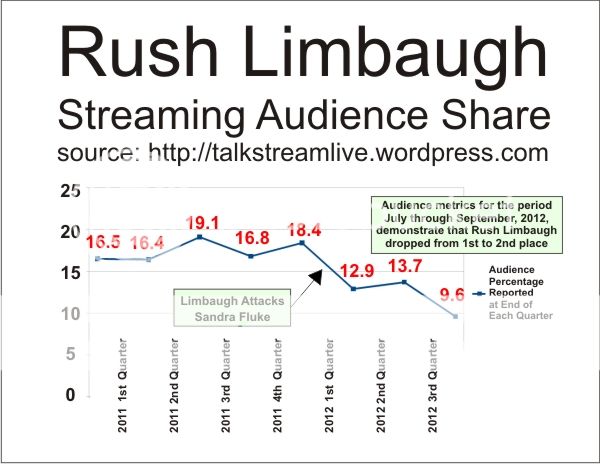The code of silence has been swept away. Throughout the radio industry this week, there is talk of the devastating impact of Limbaugh's Fluke attack. Rush supporters are, of course, in denial. But compelling personal testimonies are suddenly out in the open, and they will prove difficult to dismiss.
 The Limbaugh advertiser boycott is real, and
The Limbaugh advertiser boycott is real, and
the radio industry is finally beginning to talk about it
For example Doug Stephan, president of Stephan MultiMedia and host of the nationally syndicated “Good Day” program, had this to offer:
[excerpt] Let’s face it, the agencies and advertisers are how we survive. So to tell them that their clients are stupid for not staying in an atmosphere in which they don’t want to be is akin to the Republicans not reading the tea leaves about changing demographics.
I’m not here to argue the point, but rather to tell you what this ONE incident has cost me as an independent in a sea of big corporate operators, who are obviously losing tens of millions of dollars due to this one event.
So far this year, my losses are in the hundreds of thousands of dollars. Cancellations, avoidance and decisions to just not buy across the whole format, no matter what the content...
I’m not looking for Limbaugh to send me a check (although that would be nice), but I do think we have to let it be known that his actions have been devastating to our survival. [emphasis added]
—Doug Stephan: Talk Must Expand Beyond Politics to Survive, November 19, 2012
I think it took
Dial Global's devastating fall, and
subsequent fingering of Limbaugh as partly responsible, to break loose the conversation.
An analysis of Limbaugh audience numbers,
after the jump
The business model for a public air waves radio station is matching advertising dollars with listeners. Advertising pays all the bills. It becomes obvious, then, that advertisers are the real power behind any publicly broadcast program. Advertising funds program content, and all else.
An advertiser boycott does not directly influence audience. Rather, it focuses on the funding that makes listenership possible. Thus, the best measure of the impact of an advertiser boycott (in the short term) is, what's happening to the radio conglomerates? Three of the biggest, — Dial Global, Cumulus, and Clear Channel — all appear to be in trouble.
Until the radio networks or groups of stations actually capitulate by cutting Limbaugh programming, however, any measure of decreased audience share is merely gratuitous. If Limbaugh is on the radio in a given market, he is likely to find an audience. Thus, while we may find any decrease in listenership or audience share tantalizing, it isn't likely to prove decisive in any sense.
There are multiple reasons for this. Listener data in radio is open to interpretation, and may vary from one market area to another, and from one market segment to another.
There are basically three methods of measuring audience numbers. The old method was to pay listeners to keep diaries, and record their listening histories for later compilation and analysis by the company. Some areas of the company still rely upon diaries. The method is prone to error, not only due to tendencies to over-report favorite programs, but also due to possible errors in number transcription. Diaries are gradually being replaced by a technological solution called PPM which measures actual listening time, and operates on a silent code transmitted by radio stations.
The Portable People Meter is: "...worn like a pager, and detects hidden audio tones within a station or network's audio stream, logging each time it finds such a signal. It has proved to be much more accurate than the old handwritten logs or wired meters, and is immune to forgetful test subjects."
And finally, there is streaming audio. Diaries and PPM rely upon sampling; streaming audio is better at assessing totals. One aspect of streaming audio is computer transmission. Within a given segment of the audience, streaming audience measurements are able to measure the entire number of program instances, and therefore provide a very precise audience count.
The limitation of streaming audio, however, is that the given segment of audience may be partial, small, or limited in some other way.
 Sandra Fluke
Sandra Fluke
Earlier this year, Rush Limbaugh was on top of the talk show hosts ladder, a place of honor in the industry that Limbaugh had held for six years previous. The standard method of measure is conducted by the Arbitron company.
Arbitron is very careful to prevent its raw data from becoming generally available. It is, after all, a product that the company sells. Therefore, it was possible for some to declare in May that Rush Limbaugh's ratings took a dive, while others essentially argued the opposite. Those with access to actual, total raw data consider it a commodity, and therefore typically would have no interest in weighing in on such disagreements.
A trend may likewise be reported for one market — Limbaugh down ten percent — and be mis-interpreted as a measure of the entire country. A further complicating factor — audience may be measured in raw numbers, or as a percentage of audience share.
Unfortunately, the Nate Silvers of radio listenership sell their services to specific companies, rather than providing them for free to the general public. Thus, we're left with snatches of information on which to base our estimates of audience share.
In my recent article, The Rush Limbaugh advertiser backlash is knocking down the radio networks, I wrote, "in the only recent audience analysis (of streaming audience share) to have been released, Limbaugh has been knocked out of first place, and has seen audience share decrease by nearly fifty percent." Unfortunately, other websites (here and here) have interpreted this to indicate that Limbaugh's audience share is down by half across the board.
This tells me that I wasn't careful enough to qualify my statement; nor to qualify the title of the linked article. I apologize for any misunderstanding. I know the implications of a streaming audio evaluation; some of my readers may not.
So this article is, in part, an attempt to clarify two points:
| o Streaming audio measurements very accurately measure the listenership via one aggregator (one computerized delivery system), but may offer only a hint of what may be happening with the rest of a talk show audience
o Concerning the advertiser boycott, the advertisers and conglomerates are of concern, the size of the audience is incidental
|
Let us take another look at the streaming audio measurements that show a nearly fifty percent drop:
 Based upon data from Talk Stream Live
Based upon data from Talk Stream Live
The raw data is published in a blog for Talk Stream Live. Talk Stream is an iTunes app for iPhone, iTouch and iPad. [Facebook link]
Their scope and methodology are not readily discernible. Therefore, this may be interpreted as — in some portion of the Apple-based streaming market — Limbaugh's audience share having dropped by nearly half.
This may lead to speculation: because it appears to be a measure of streamed audio listening, does that correspond to a younger "iAudience"? Could that suggest that Limbaugh's tirade against a student turned off a significant portion of his younger listener demographic? If so, what might that bode for the future of conservative talk?
Talk Stream Live reports that Limbaugh has dropped to second place in audience share, behind Michael Savage. Once again, this is for one segment of the listening audience. Thus, it may be helpful to appreciate trends, yet says little about total listenership.
Another streaming audio analysis shows Limbaugh's audience as relatively stable since the first of the year:
 Popularity Trend graph for Rush Limbaugh's audience,
Popularity Trend graph for Rush Limbaugh's audience,
raw audience numbers from Streaming Radio Guide
Dec 27, 2009 (left) through Nov 18, 2012 (right)
Once again, information about scope and methodology are not readily available. This graph depicts a segment of Limbaugh's audience, not the entire audience. It may be useful for appreciating trends, if any.
Talkers.com shows the Limbaugh audience at 14.75 million for 2012. The Daily Beast argued in the immediate aftermath of the Limbaugh/Fluke tirade that these numbers are likely fudged.
For the tens of thousands seeking to Flush Rush, the audience numbers shouldn't matter. Our mission is to educate the sponsors of hate radio about their sponsorship, knowing that eventually the audience numbers will take care of themselves.
Hat tip to HiBob for correcting an error in the diary.
The diarist is active in Flush Rush on Facebook:

Flush Rush on Facebook: http://facebook.com/...
Stop Rush database: http://stoprush.net
My Stop Rush blog posts: http://dailykos.com/...
Twitter hashtag: #stoprush


